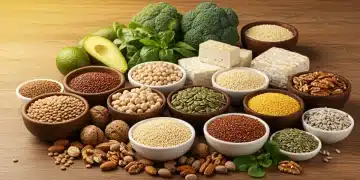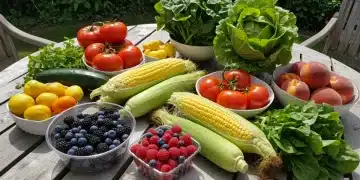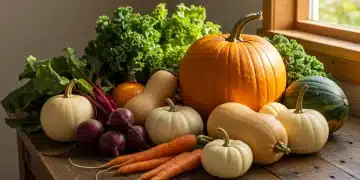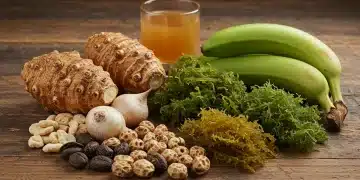Organic vs. Conventional: 2025 Grocery Cart Analysis
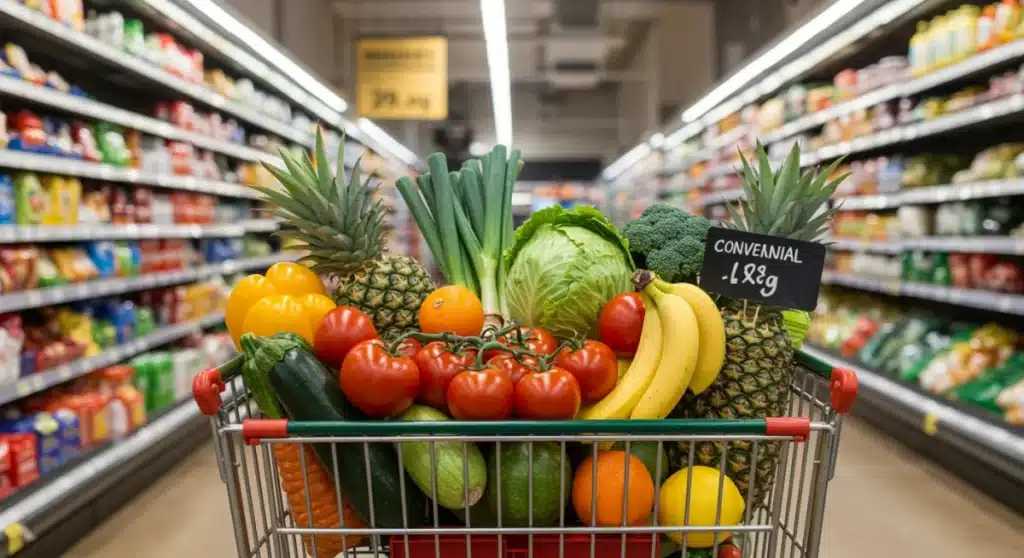
Understanding the distinction between organic and conventional foods in 2025 is vital for making informed decisions that impact personal health, environmental sustainability, and household budgets as consumer demands evolve.
Choosing between organic and conventional produce has become a central dilemma for many consumers navigating grocery aisles. With evolving agricultural practices and increasing awareness of health and environmental impacts, a organic vs conventional food analysis in 2025 is more relevant than ever. This guide aims to provide a data-driven perspective to help you make informed decisions for your grocery cart, considering factors from nutritional value to economic implications.
Understanding Organic and Conventional Labeling
The first step in making an informed choice is to understand what the labels ‘organic’ and ‘conventional’ actually mean. These terms are not just marketing slogans; they represent distinct agricultural standards and practices that govern how food is grown, processed, and brought to your table. In the United States, the USDA Organic seal signifies a rigorous certification process, ensuring adherence to specific guidelines.
For a product to be labeled organic, it must meet stringent criteria set forth by the National Organic Program (NOP). This includes avoiding synthetic fertilizers, pesticides, genetically modified organisms (GMOs), irradiation, and sewage sludge. Livestock raised organically must also be fed organic feed, have access to the outdoors, and not be given antibiotics or growth hormones. Conventional farming, on the other hand, permits the use of these substances and practices, often prioritizing yield and efficiency.
Organic Certification Standards
The USDA Organic certification is a multi-step process that involves annual inspections and strict record-keeping. This ensures that farms and handling facilities comply with organic regulations. Consumers can trust the USDA seal as an indicator of these practices.
- Soil Management: Organic farms focus on soil health through composting, cover cropping, and crop rotation.
- Pest Control: Biological controls, beneficial insects, and approved natural substances are used instead of synthetic pesticides.
- Animal Welfare: Organic livestock must have outdoor access and live in conditions that accommodate their natural behaviors.
Understanding these foundational differences is crucial. The presence or absence of the USDA Organic seal directly impacts how a product was produced, influencing its environmental footprint and potential chemical residues. This forms the basis of the ongoing debate and consumer choices in the marketplace.
In conclusion, the distinction between organic and conventional food is rooted in their production methods, with organic farming adhering to a comprehensive set of standards aimed at ecological balance and resource conservation. These standards are rigorously enforced to maintain consumer trust and ensure the integrity of the organic label.
Nutritional Content: Is Organic More Nutritious?
One of the most frequently debated aspects of the organic vs conventional food discussion revolves around nutritional content. Many consumers opt for organic produce believing it to be inherently more nutritious than its conventional counterparts. While research has yielded mixed results over the years, recent data and meta-analyses provide a clearer picture for 2025.
Several studies suggest that organic produce may contain higher levels of certain antioxidants and vitamins, while also having lower concentrations of nitrates and cadmium. Antioxidants, like polyphenols, are beneficial compounds that protect cells from damage. However, the differences are often marginal and can be influenced by various factors such as soil quality, climate, and harvesting times, regardless of farming method.
Key Nutritional Findings
A comprehensive review in 2024 highlighted specific nutrients where organic foods show slight advantages. For instance, organic milk and meat have consistently shown higher levels of omega-3 fatty acids, which are crucial for heart and brain health. This is largely attributed to the diet of organically raised animals, which typically includes more pasture grazing.
- Antioxidants: Organic fruits and vegetables may contain up to 20% higher levels of certain antioxidants.
- Omega-3s: Organic dairy and meat often feature a more favorable fatty acid profile.
- Vitamins and Minerals: While some studies show slight variations, overall vitamin and mineral content is often comparable.
It’s important to recognize that the primary determinant of nutritional value in any food, whether organic or conventional, is its freshness and how it’s prepared. Eating a wide variety of fruits, vegetables, and whole grains, regardless of their organic status, is the most impactful strategy for a healthy diet. The slight nutritional edge of some organic foods should be weighed against their cost and availability.
Ultimately, while organic foods might offer a modest nutritional boost in specific areas, the overarching message for 2025 remains that consuming plenty of fruits and vegetables, irrespective of their farming method, is paramount for health. The nutritional differences are often not significant enough to outweigh the benefits of simply eating more produce.
Pesticide Residues and Health Concerns
A significant driver for consumers choosing organic options is the concern over pesticide residues. Conventional farming relies on synthetic pesticides to protect crops from pests and diseases, while organic farming prohibits their use, opting for natural alternatives. This difference raises valid questions about potential health impacts, particularly regarding long-term exposure.
Data from the Environmental Working Group’s (EWG) ‘Dirty Dozen’ and ‘Clean Fifteen’ lists annually highlights produce with the highest and lowest pesticide residues, respectively. While regulatory bodies like the Environmental Protection Agency (EPA) set safe limits for pesticide residues, some consumers prefer to minimize their exposure entirely. Organic certification aims to address this concern directly.
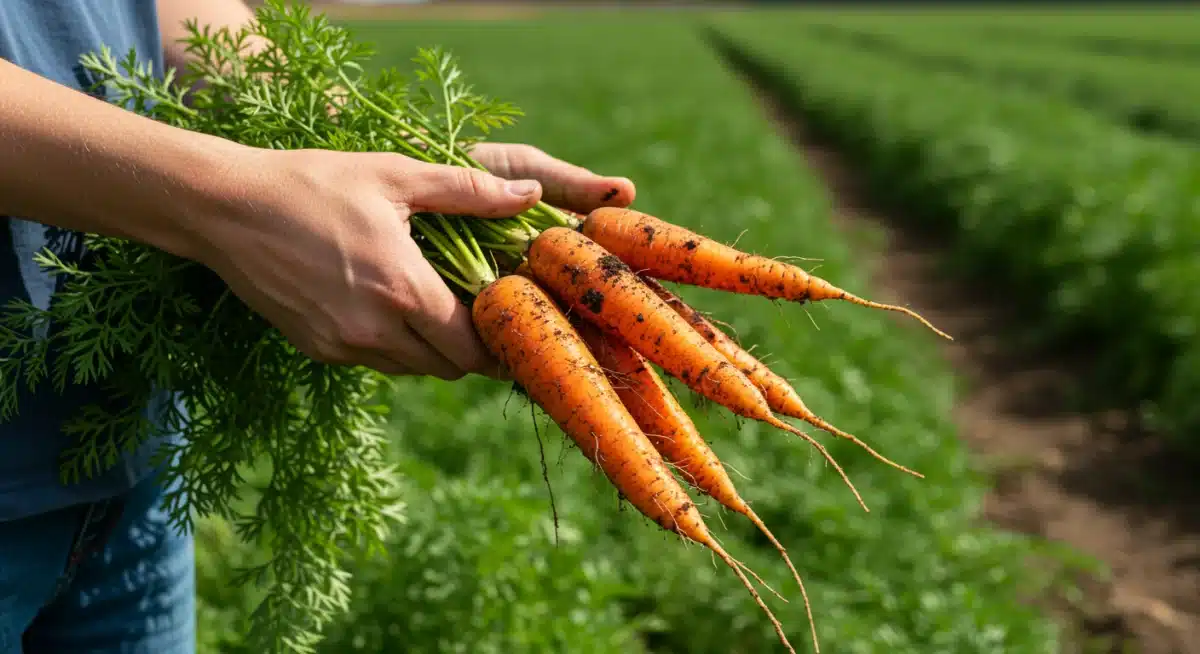
Minimizing Exposure to Pesticides
Studies have shown that individuals who consume primarily organic diets tend to have lower levels of pesticide metabolites in their urine. This indicates a reduced exposure, which some public health advocates argue is beneficial, especially for vulnerable populations such as children and pregnant women. The long-term effects of cumulative exposure to low levels of multiple pesticides are still an area of ongoing research.
- Organic Advantage: Significantly lower levels of synthetic pesticide residues compared to conventional produce.
- Regulatory Oversight: EPA sets maximum residue limits (MRLs) for conventional produce to ensure safety.
- Consumer Choice: The choice between organic and conventional often comes down to personal risk tolerance and preference for minimizing chemical intake.
It’s also important to note that conventional produce, when washed thoroughly, can have significantly reduced surface residues. The benefits of consuming fruits and vegetables, even conventional ones, far outweigh the potential risks associated with pesticide exposure at current regulatory levels. However, for those seeking to actively reduce chemical load, organic options provide a clear pathway.
In summary, while regulatory standards aim to ensure the safety of conventional produce, organic farming offers a method to significantly reduce exposure to synthetic pesticide residues. This aspect remains a primary consideration for many consumers when making their grocery choices, particularly when prioritizing a lower chemical footprint in their diet.
Environmental Impact: Sustainability Differences
Beyond personal health, the environmental implications of food production are a major factor in the organic vs conventional food debate. Both farming methods have their unique impacts on soil health, water quality, biodiversity, and climate change. Understanding these differences is crucial for consumers focused on sustainability.
Organic farming practices are generally lauded for their emphasis on ecological balance. By avoiding synthetic pesticides and fertilizers, organic methods reduce chemical runoff into waterways, which can harm aquatic ecosystems. They also promote biodiversity, supporting a wider range of beneficial insects, birds, and soil microorganisms. Soil health is a cornerstone of organic agriculture, leading to better water retention and reduced erosion.
Resource Management and Climate
While organic farming often requires more land to produce the same yield as conventional farming, its practices can lead to lower energy consumption and greenhouse gas emissions per unit of land. Conventional farming, on the other hand, can be more land-efficient but often relies on energy-intensive synthetic inputs and machinery, contributing to a larger carbon footprint.
- Soil Health: Organic practices enhance soil fertility and structure, reducing erosion and increasing carbon sequestration.
- Water Quality: Reduced use of synthetic chemicals minimizes water pollution from agricultural runoff.
- Biodiversity: Organic farms often support richer ecosystems due to diverse cropping and natural pest control.
- Energy Use: Conventional farming’s reliance on synthetic inputs can lead to higher energy consumption in production.
The discussion around environmental impact is complex, with both systems presenting trade-offs. Conventional farming’s efficiency can feed more people on less land, but at a potential cost to ecosystem health. Organic farming’s benefits to biodiversity and soil are clear, but its lower yields can raise questions about scalability and food security for a growing global population. Innovations in both sectors are continually striving for more sustainable practices.
To conclude, organic agriculture generally offers significant environmental benefits, particularly in terms of soil health, water quality, and biodiversity. However, conventional farming’s efficiency in land use also plays a critical role in global food supply, making the choice a nuanced consideration for environmentally conscious consumers.
Economic Considerations: Cost vs. Value
The price difference between organic and conventional foods is perhaps the most immediate and tangible factor for many shoppers. Organic products typically carry a higher price tag, a reality that often influences purchasing decisions. Understanding why this cost disparity exists and evaluating the true value proposition is essential for a 2025 grocery budget.
The higher cost of organic food can be attributed to several factors. Organic farming methods are often more labor-intensive, relying on manual weed control and natural pest management rather than chemical shortcuts. The certification process itself involves annual fees and inspections. Moreover, organic yields can sometimes be lower than conventional yields, meaning farmers need to charge more per unit to cover their costs and make a profit.
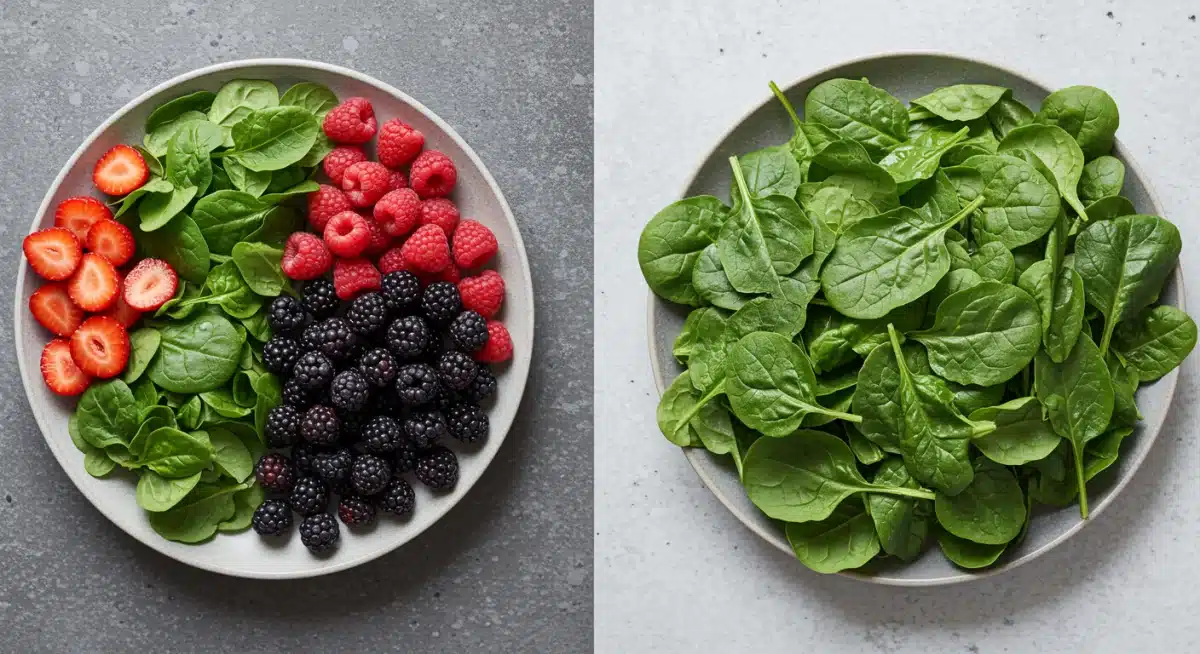
Budgeting for Organic Choices
For consumers on a budget, strategic organic shopping can make a significant difference. Prioritizing organic for items on the ‘Dirty Dozen’ list, known for higher pesticide residues, can be a cost-effective approach. Conversely, opting for conventional produce from the ‘Clean Fifteen’ can help save money without significantly increasing exposure to harmful chemicals.
- Higher Production Costs: Labor-intensive methods and lower yields contribute to increased organic prices.
- Certification Expenses: Farmers incur costs for organic certification and compliance.
- Strategic Shopping: Focusing organic purchases on specific items (e.g., ‘Dirty Dozen’) can optimize budget.
- Value Perception: Consumers often weigh the perceived health and environmental benefits against the higher cost.
The value of organic food extends beyond immediate nutritional benefits to encompass environmental stewardship, animal welfare, and reduced chemical exposure. For some, these intangible benefits justify the higher price. For others, affordability and accessibility of conventional food remain paramount. The market for organic products continues to grow, suggesting a rising consumer willingness to invest in these values.
In conclusion, the economic aspect of choosing organic versus conventional food involves a trade-off between higher prices and the perceived value of health, environmental, and ethical benefits. Strategic purchasing and understanding which items offer the most significant differences can help consumers manage their budgets effectively while aligning with their values.
The Future of Food: Trends and Innovations by 2025
As we move further into 2025, the landscape of food production and consumer choice is continually evolving. The organic vs conventional food debate is not static; it is influenced by new technologies, shifting consumer preferences, and urgent global challenges like climate change and food security. Understanding these trends provides insight into the future of our grocery carts.
Innovation is occurring in both organic and conventional sectors. Organic farming is exploring advanced biological pest controls, precision agriculture techniques adapted for organic standards, and improved seed varieties that thrive without synthetic inputs. Conventional agriculture is also making strides in sustainability, with increased adoption of practices like reduced tillage, cover cropping, and smart irrigation, alongside the development of more targeted and environmentally friendly pesticides.
Emerging Food Technologies
Beyond traditional farming, new food technologies are blurring the lines and offering alternative solutions. Vertical farms, for instance, can produce crops with minimal land and water, often without pesticides, regardless of whether they adhere strictly to organic certification rules. Cultivated meat and plant-based alternatives are also gaining traction, offering new options that bypass many of the environmental concerns associated with traditional animal agriculture.
- Precision Agriculture: Optimizing resource use in both conventional and organic systems.
- Biotech Solutions: Developing resilient crops that require fewer external inputs.
- Alternative Proteins: Plant-based and lab-grown options reducing reliance on traditional farming.
- Supply Chain Transparency: Consumers demanding more information about food origins and production methods.
Consumer demand for transparency, sustainability, and health continues to shape the market. Retailers are responding by offering a wider array of choices, from certified organic to locally sourced conventional produce. The emphasis is increasingly on informed decision-making, where consumers can weigh various factors beyond just ‘organic’ or ‘conventional’ labels, considering the specific farm, region, and production practices.
In conclusion, the future of food in 2025 is dynamic, marked by innovations in both organic and conventional farming, as well as the rise of new food technologies. Consumers are becoming more discerning, seeking transparency and sustainability, which will continue to drive advancements and diversify the options available in our grocery carts.
Making Informed Choices for Your Grocery Cart
Navigating the complex world of food choices, particularly the organic vs conventional food dilemma, requires a balanced approach. There’s no single ‘right’ answer that fits everyone, as personal values, health priorities, budgetary constraints, and environmental concerns all play a role. The goal is to empower you with the information needed to make choices that align with your individual circumstances and beliefs.
Consider what matters most to you. Is it minimizing pesticide exposure, supporting biodiversity, ensuring animal welfare, or adhering to a strict budget? Each of these factors weighs differently for each consumer. Remember that the overall health benefits of consuming plenty of fruits and vegetables far outweigh the nuances of their production method. Prioritizing fresh, whole foods should always be the foundation of a healthy diet.
Personalizing Your Food Strategy
A practical approach for many is to adopt a ‘flexitarian’ or ‘conscious consumer’ mindset. This might involve purchasing organic for items known to have higher pesticide residues (the ‘Dirty Dozen’) and opting for conventional for others. Supporting local farmers, regardless of their organic certification, can also be a way to ensure freshness and reduce your food’s carbon footprint, while also boosting local economies.
- Prioritize Produce: Focus on consuming a wide variety of fruits and vegetables daily.
- Consider ‘Dirty Dozen’ / ‘Clean Fifteen’: Use these lists to guide selective organic purchases.
- Support Local: Buying from local farms, organic or conventional, promotes freshness and community.
- Read Labels: Look beyond ‘organic’ for other certifications related to animal welfare or fair trade.
Ultimately, the most powerful tool you have as a consumer is information. By understanding the production methods, nutritional profiles, environmental impacts, and economic realities of both organic and conventional foods, you can make deliberate choices. These choices not only impact your health but also contribute to the broader food system, shaping its future direction.
In conclusion, making informed choices for your grocery cart in 2025 involves a personalized strategy that balances health, environmental, and economic factors. There is no universally superior option; instead, it is about understanding the nuances of organic vs conventional food and selecting products that best meet your personal values and needs.
| Key Aspect | Brief Comparison |
|---|---|
| Production Methods | Organic avoids synthetics; Conventional uses them for efficiency. |
| Nutritional Content | Often comparable, with some organic advantages in specific antioxidants/omega-3s. |
| Pesticide Residues | Organic has significantly lower levels of synthetic residues. |
| Cost & Value | Organic generally costs more, reflecting production methods and perceived benefits. |
Frequently Asked Questions About Organic vs. Conventional Food
While some studies suggest organic foods may have slightly higher levels of certain antioxidants and omega-3 fatty acids, overall nutritional differences are often marginal. The most significant factor for nutrition remains consuming a diverse diet rich in fruits and vegetables, regardless of their organic status.
Organic foods are not entirely pesticide-free, as they can be exposed to naturally occurring pesticides or drift from conventional farms. However, they are produced without synthetic pesticides, which significantly reduces the presence of these chemicals compared to conventional produce.
Organic farming practices often promote better soil health, biodiversity, and reduced water pollution due to the absence of synthetic chemicals. While organic yields can be lower, its holistic approach generally supports more sustainable ecosystems compared to many conventional methods.
Organic food’s higher price stems from more labor-intensive farming practices, lower yields per acre, the costs associated with organic certification, and stricter regulations. These factors increase production expenses, which are then passed on to the consumer.
To make organic food more budget-friendly, consider prioritizing items on the ‘Dirty Dozen’ list for organic purchases, buying seasonal organic produce, and checking for sales. You can also explore local farmers’ markets for potentially more affordable organic or sustainably grown options.
Conclusion
The journey through the organic vs conventional food landscape in 2025 reveals a complex interplay of factors that extend far beyond simple nutritional comparisons. From understanding stringent organic certification processes to weighing the nuanced impacts on personal health, environmental sustainability, and household budgets, consumers are equipped with more data than ever. There is no universal answer, but rather a spectrum of choices that reflect individual values and priorities. By staying informed about evolving agricultural practices and emerging food technologies, consumers can confidently curate a grocery cart that supports their health, their community, and the planet, making conscious decisions that contribute to a more sustainable and equitable food system for all.
